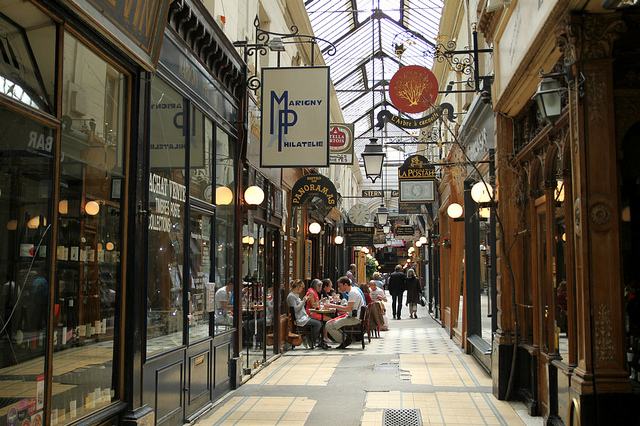Were Paris almost any other city, its covered arcades might be considered one of its main attractions. As things are, most tourists are too distracted by the French capital’s embarrassment of postcard wonders to even know these wonderful museums of commerce exist.

Passage des Panoramas (Photo: Mathieu Margollé via Flickr)
A forerunner to shopping malls, the passages were considered a visionary new idea when they were constructed in the early half of the nineteenth century. They were dry, illuminated, and in some cases heated, extending shopping hours and making consumption a true leisure activity.
Yet buying their wares is far from necessary in enjoying what the arcades have to offer. As well as boasting beautiful and varied architectures of marble, iron, and glass, these passages have long been a paradise for browsers of both people and things.
By the mid-nineteenth century the arcades were a Mecca for the most Parisian of archetypes: the flaneur: a sort of observer-stroller kind of individual who practiced what the writer Balzac referred to as the “gastronomy of the eye”. Flaneurs walked slowly, taking everything in, from the people talking at restaurants to the food being served on their plates. Fine advice for any traveller, in any part of the world!
A Wander of Your Own
There are fewer than 20 of the original nineteenth century arcades left standing today (there were once more than 150). Most thread between boulevards in Paris’s Second and Ninth Arrondissements. All are worth exploring, but a good walk that shows off the best of what the covered passages have to offer is the one that begins at Cadet Metro and takes the aspiring flaneur all the way to Bourse with barely breaking cover.
The first arcade on this journey is the Passage Verdeau, which branches from the Rue Faubourg Montmartre. Quiet in comparison with other passages to come, Verdeau boasts a typically beautiful arching glass roof and is home to numerous antique dealers, where browsing is seldom disrupted by the crowds.
A quick dash through the open on the rue de la Grange-Batelière takes you to the Passage Jouffroy, built in 1845. This was the first of the arcades to be heated and the first to have a roof built entirely of iron and glass.
In 1987 Jouffroy was lovingly, though not excessively, restored: it still retains an air of faded grandeur, with distressed woodwork bowing low over shop fronts and a floor of white and grey tiles that tells centuries of footfall. The first part of Jouffroy is dominated by the Librairie Paul Vaulin, a vast bookshop over three levels, selling rare and second hand works to be browed through, as well as a selection of photograph-heavy reference books in both English and French.
After a flight of stairs leading past the entrance to Hotel Chopin — a charming two star establishment that opened its doors the same year as Jouffroy itself — one whole side of the arcade is taken up by the the Musee Grevin, a kitsch wax works museum, founded in 1882 and filled by a century-spanning array of attractions, from Jean-Paul Marat to Zinedine Zidane.
Jouffray opens out onto the Boulevard Montmartre, one of Paris’s main thoroughfares and less… picturesque roads. Here is modern Paris at its most no-nonsense. Chain pubs and superstores line its sidewalks, while four lanes of traffic rumble along its length. The difference after Jouffroy can be abrupt, and it’s easy to feel strangely exposed as you hurry across the road, making for Passage des Panoramas on the other side; a sensation that the arcades represent a city within a city becomes acute.
An Old Modern Place
Passage des Panoramas is one of the oldest of the arcades; it is lined with faux-marble columns and tiled in a beautiful, ornate fashion. Originally constructed in 1800, Panoramas was also the first public place in Paris to receive gas lighting, which it did in 1817. Despite its heritage, there is still much that feels modern about Panoramas — and this is also true of the other arcades. They are places of commerce, after all, and commerce does not stand still.
Alongside the beautifully detailed traditional French bistros, the hand-painted signs, and the shops selling collectables are many outlets that belong resolutely in the 21st Century. Places like Gyoza Bar, a Japanese restaurant with a minimalist interior and menu, or Noglu, a Scandinavian inspired bistro with a dedication to gluten free food. Likewise, Les Grandes d’Espagnes, a purveyor of Spanish delicacies: sampling its charcuterie selection in its monochrome interior, it’s hard to believe hung meat has meat has ever tasted so cool.
There is a sense that time moves differently higher up in the arcades than it does at street level: while the nineteenth century rafters do little but look beautiful and gather dust, the street remains vibrant and changes day by day.
And while the passages may rank comparatively low on many tourist agendas, come lunchtime one can hardly move for feasting Parisians. Livelier more arresting scenes are hard to imagine. To walk through them is a feast for all the senses, not only the eyes, so the only trouble is deciding where to stop for a meal of your own.
The flaneurs, of course, would encourage you not to stop, only to walk slowly and with your senses open — Baudelaire even remarks of a trend among some flaneurs of walking a turtle on a leash to slow their pace. The philosophy behind this: why settle for one meal when you can imagine having them all?